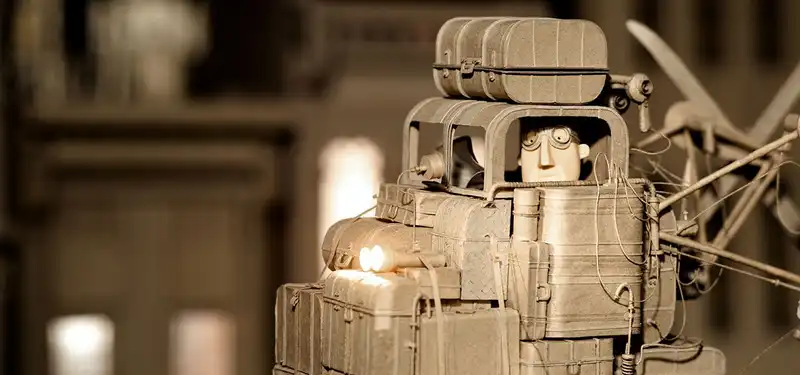Jan 6, 2018
The Mysterious World of Cardboard in Daniel Agdag's "Lost Property Office
In a sepia-toned world, a man is repairing an abandoned toy robot. Behind him looms the shelves of a huge warehouse, crammed with umbrellas, cameras, ski boards, rackets, and bags of all sizes.
As a faithful caretaker of the local transit system's lost and found, Ed has lovingly retrieved and labeled the misplaced belongings of hundreds, if not thousands, of commuters until one day he is notified that his services are no longer needed. This is the quiet, thoughtful story of Daniel Agdag's "Lost Property Office," a stop-motion film that could be nominated for an Academy Award for Best Animated Short.
Agdag worked with a small, dedicated team of only three people at the center to bring his vision to life. Producer Liz Carney secured funding (the application took four years to process) and negotiated music rights, while Melanie Etchell handled compositing, color grading, graphic design, and costume design and production. Pierce Davison animated most of the film and custom-built the motion control equipment, and Agdagh himself served as director, cinematographer, and editor.
Agdag also built all sets and props. Aside from the silicone and metal used for the puppets and the fabric used for the clothing, most of the sets were made from over 2,500 pieces of recycled cardboard and 1,258 unique parts and props were created. Early in the production process, Agdag attempted to use brown paper for the dolls' clothing, but quickly discarded this idea because the paper was too fragile for animation.
"We used three different gauges of the material, which is surprisingly sturdy. All sets are self-supporting by their construction, so no additional material is needed for support."
Despite this, the animation was not all rosy. Agdag admits
that "cardboard is not the most practical material to use for animation, as it is very susceptible to set displacement."
Space constraints also posed significant difficulties in filming. Filming was done primarily with used Olympus OM manual prime lenses, which Agdag collected over the course of a year. The room we were shooting in was about 3 x 5 meters square, and the city set filled the entire wall. It was a really delicate process to make sure we didn't trip [on the set] during the shoot and ruin the shot.
On top of that, he and his team had to move the studio space three times during production, each time making the room smaller and smaller.
Even before "Lost Property Office," Agdag was respected as the architect of highly elaborate flying machines and unlikely structures (all made of cardboard, of course). Until recently, some of Agdag's latest fanciful sculptures, reminiscent of Hayao Miyazaki's outlandish aviation designs, were on display at the MARS Gallery in his native Melbourne, Australia. (In a very meta reference, a poster inspired by one of Agdag's works appeared in Lost Property Office, with the words "SETS FOR A FILM I'LL NEVER MAKE.")
Agdag's taste for designing flying boats is demonstrated in the final scene of "Lost Property Office," where he constructs an ingenious escape boat from some of the forgotten items Ed has collected over the years. He starts out on the railroad in a one-person cart, which he unfolds to reveal two propellers (made of ski boards) and a balloon that allows him to fly over a cardboard city, brightly lit against a starry sky.
One might think that the Lost Property Office's masterful combination of engineering and storytelling is the result of careful execution of a carefully crafted plan, but according to Agdag, his process is decidedly haphazard. What I wanted to know was whether he tends to stick to the initial storyboard. I like to play with the scene on the day of shooting. Especially with stop-motion animation, when you are on set on an actual set, it feels very different from the two-dimensional picture you first envisioned. I went so far as to create additional elements after seeing the set prepared onstage (for the first time), and in many cases it was much better than the storyboard arrangement."
And while the short story is based on an unfinished work by his friend Nicolas Gunn, who writes and performs in the play, Agdag deviated quite significantly from the original idea. After our initial collaboration," he says, "I went away and wrote an outline based on the concept, and the script evolved from there. The script evolved from there," he says. The film doesn't follow the original concept at all, but I think it was the driving force behind the project."
One of the crucial changes was to not have Ed have the character of a bellhop friend. As Agdag explains, "I thought it would be more economical for the story and reinforce Ed's sense of loneliness and isolation to combine this companion with the lost and found at the train station."
Aside from Gunn's story, Agdag drew inspiration from several favorite artists. Perhaps the most famous is Edward Hopper, whose name is the same as the film's protagonist. Agdagh is also a fan of the American painter's seminal "Nighthawks" and the work of Australian artists John Black and Jeffrey Smart. In the scene before the title card of the short film, Agdagh describes Black's "Collins St.,"
"Most of my aesthetic inspiration comes from my favorite painters," says Agdagh.
"My imagination tends to be heightened when I'm staring at a still image in silence.Agdag's thoughts on the creative process reflect the somewhat melancholic atmosphere of his films. He says, "There are many times when I look at the puppets in the dark and wish I had done it better, or done it better, or done it differently. Making an animated film is like living life in super-slow motion. The only proof is the film itself."
.



Post your comment